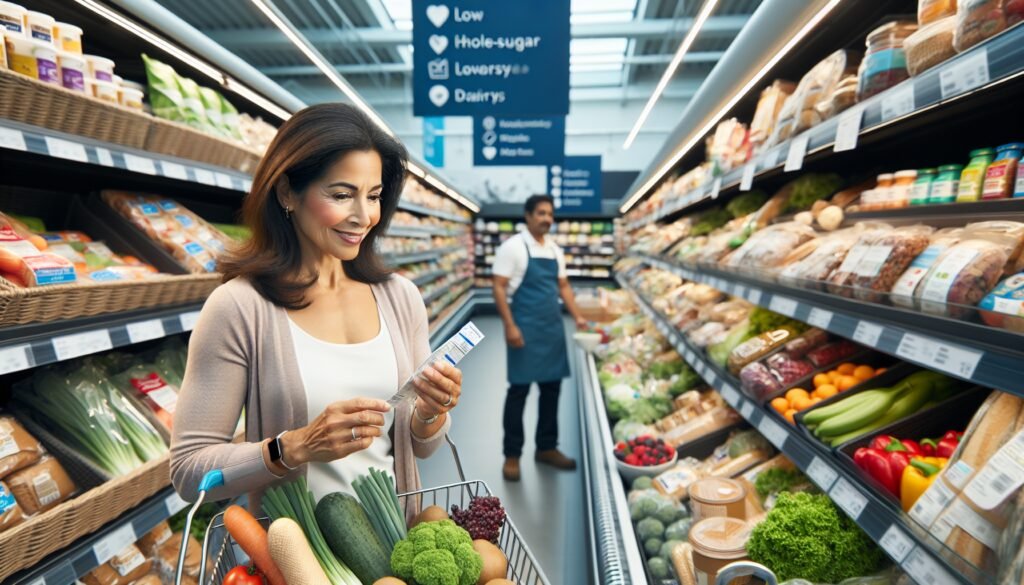
Managing diabetes effectively calls for a careful approach to food shopping and meal planning. A well-thought-out grocery list is essential for maintaining a balanced diet that keeps blood sugar levels in check. With the right strategy, individuals living with diabetes can enjoy a wide variety of foods while also taking care of their health.
Here's your guide to food shopping for diabetes, encompassing everything from creating a diabetes-friendly meal plan to understanding nutrition labels. Make informed choices at the grocery store with these tips and recommendations, and transform the way you view your diabetes management.
What you\'ll find in this article?
- How to make a diabetes-friendly meal plan
- Foods to add to your cart
- Foods to leave out of your cart
- Tips for grocery shopping with diabetes
- How to read a nutrition facts label
- Meal planning tips for diabetes
- Healthy staples to add to your shopping list
- Exploring Questions on Diabetes-Friendly Shopping
How to make a diabetes-friendly meal plan
Meal planning is a cornerstone of diabetes management. It involves thinking ahead and preparing meals that align with your health goals. Start by considering the balance of macronutrients - carbohydrates, proteins, and fats - to ensure each meal is satisfying and blood sugar-friendly.
Carbohydrates have the most significant impact on blood sugar levels, so opt for complex carbs like whole grains, legumes, and vegetables. Incorporating lean protein options and healthy fats will help stabilize blood sugar. Lastly, remember to factor in portion sizes, which can significantly affect glucose control.
For meal inspiration, turn to diabetes-friendly recipes that combine flavor and nutrition. Browse online resources and apps for ideas that can be tailored to your dietary needs. Remember, the goal is to find meals you enjoy that also support your health objectives.
By planning your meals in advance, you can avoid the temptation of impulsive eating, which often leads to less healthy choices. A meal plan also makes grocery shopping more efficient, saving you time and money.
Explore our specialized services in diabetes care 🌟.
From personalized diet plans to effective exercise routines, we have what you need to take control of Type 2 Diabetes.
Visit our services page now!












Foods to add to your cart
When food shopping for diabetes, your cart should be filled with foods that support blood sugar management. Look for high-fiber options like fruits and vegetables, especially those low on the glycemic index, such as berries and leafy greens.
Diabetes-friendly dairy products like low-fat yogurt and milk can provide calcium and protein without excessive sugars. Whole grain products offer sustained energy and can help manage glucose levels.
Don't forget about the importance of healthy lunch options for diabetics, which should include a mix of complex carbohydrates, protein, and healthy fats to keep you energized and satiated throughout the day.
- Best fruits for diabetics: Berries, apples, pears
- High-fiber foods for diabetes: Beans, lentils, whole grains
- Lean protein options for diabetics: Chicken breast, tofu, fish
Foods to leave out of your cart
Just as important as what to include in your diet is knowing which foods to avoid. Processed meats and high-sugar foods can lead to spikes in blood sugar and should be limited or excluded altogether.
Be wary of items that may seem healthy but are actually high in added sugars, such as granola bars, flavored yogurts, and salad dressings. Instead, opt for their sugar-free or low-sugar counterparts.
Trans fats, found in baked goods and snack foods, and saturated fats, common in full-fat dairy products and fatty meats, are also best avoided to maintain heart health and blood sugar control.
Tips for grocery shopping with diabetes
Successful grocery shopping with diabetes involves more than just a list of foods to buy. It's about developing strategies that help you make the best choices. Always shop on a full stomach to avoid impulse buys and stick to your list.
Use shopping lists and apps to keep on track. Many apps can scan barcodes and give you instant nutritional information, making it easier to decide on the spot.
Take advantage of sales and bulk-buying opportunities for non-perishable items like canned beans and frozen vegetables, but only if you know you'll use them before they expire.
Lastly, don't overlook the power of meal prep. Preparing meals in advance can save time during the week and ensure you have healthy, diabetes-friendly options at the ready.
How to read a nutrition facts label
Understanding nutrition labels is crucial when managing diabetes. Start by looking at the serving size and total carbohydrates per serving. This information will help you determine how much of the product you can safely consume.
Check for added sugars, which can greatly impact blood sugar levels. The ingredients list can also reveal hidden sugars — anything ending in '-ose' is usually a sugar.
Also, look for the fiber content. Foods with higher fiber can help slow down the absorption of sugar into the bloodstream, providing more stable energy levels.
Don't be fooled by 'sugar-free' or 'low-fat' labels. These products can still contain carbs that affect blood sugar, or they may have added ingredients to improve taste after removing fat.
Meal planning tips for diabetes
Successful meal planning for diabetes involves a few key principles. First, maintain a balance of nutrients in each meal, and be mindful of portion sizes — even healthy foods can lead to weight gain if eaten in excess.
Consider pre-portioning meals and snacks to avoid overeating. Using smaller plates can also trick your brain into feeling satisfied with less food.
When possible, cook meals at home. This allows you to control the ingredients and cooking methods, reducing the intake of hidden sugars and unhealthy fats often found in restaurant meals.
Finally, build flexibility into your meal plan. Life is unpredictable, and you may occasionally eat out or need to swap meals around. Planning for these instances can help you maintain control over your diet and blood sugar levels.
Healthy staples to add to your shopping list
There are certain staples that every grocery list for diabetes should include. These items are versatile, nutritious, and can be used in a multitude of recipes.
- Non-starchy vegetables: Bell peppers, broccoli, spinach
- Whole grains: Quinoa, brown rice, whole-wheat pasta
- Lean proteins: Skinless poultry, fish, legumes
- Healthy fats: Avocado, nuts, olive oil
- Low-fat dairy: Milk, cheese, yogurt
By stocking your pantry and fridge with these essentials, you'll always have the components needed for a healthy, balanced meal on hand.
Exploring Questions on Diabetes-Friendly Shopping
What to look for when buying food for diabetics?
When purchasing food for diabetics, focus on items that have a low glycemic index and are high in fiber, as they help manage blood sugar levels. Look for whole and unprocessed foods, as they are generally the healthiest options.
Check the labels for added sugars and unhealthy fats, and opt for products with minimal ingredients. Remember that fresh produce, lean proteins, and whole grains are the best choices to build a nutritious, diabetes-friendly diet.
What is a good list of food for diabetics?
A good food list for diabetics includes a variety of fresh vegetables and fruits, whole grains, lean proteins, and healthy fats. Include foods like berries, sweet potatoes, salmon, and almonds to ensure a balance of nutrients.
Remember to personalize your grocery list based on individual health goals, taste preferences, and any other dietary restrictions. Consulting with a dietitian can help tailor the list to your specific needs.
What foods can diabetics eat unlimited?
While no food can be eaten unlimitedly, there are options that diabetics can enjoy more freely. Non-starchy vegetables like cucumbers, lettuce, and peppers are low in calories and carbs, making them great for snacking or bulking up meals.
Portion control is still important, but these foods are less likely to impact blood sugar levels significantly. Fresh herbs and spices can also be used without restriction to add flavor to dishes.
What does a diabetic grocery list look like?
A diabetic grocery list should prioritize foods that contribute to steady blood sugar levels. It includes plenty of vegetables, fruits with a lower glycemic index, whole grains, lean proteins, and healthy fats.
The list might also feature specific brands or products that offer reduced-sugar or whole-grain options. Organizing the list by store section can streamline the shopping experience and help maintain focus on healthy choices.











